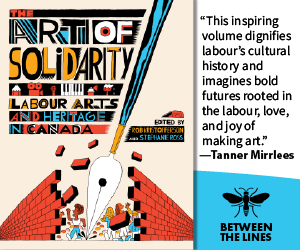Working class politics in the age of dealignment
Unions and labour organizations need to elevate worker demands to the centre of politics during election time and beyond

Trade unions have been unable to slow or reverse dealignment in working class politics, writes Fred Wilson. How has this happened? Photo courtesy Canadian Labour Congress/Facebook.
Working class politics in Canada is at a disturbing junction. There has been a shift in voting patterns, sometimes referred to as “dealignment,” in which working class voters have moved away from traditional class-based loyalties towards right-wing populist parties and movements. In the recent US election, an estimated 56 percent of working class voters cast their ballot for Trump. In Canada, through most of 2023 and 2024, a significant plurality of working class voters indicated their preference for the Conservative Party under the leadership of Pierre Poilievre.
There are multiple theses competing for narrative leadership to explain dealignment and surging working class support for right-wing populism: geopolitical and environmental crises that put tens of millions of people in motion as migrants pour across borders; a rise of individualism and rebellion that took root in the trauma of the COVID crisis; an inflation and affordability crisis after the COVID recession; a cultural backlash to identity politics and advances for women, especially among young men; disinformation and social media; a growing political divide between those with and without post-secondary education, and; the failures of social democratic and liberal parties that associated themselves with neoliberal globalization and abandoned the working class.
But there is another less discussed yet important factor in the drift of working class voters away from traditional values and politics—the problematic role and capacity of trade unions and the labour movement to influence working class political outlooks and choices.
It should be no surprise that trade unions have been unable to slow or reverse dealignment in working class politics. Put simply, the large majority of private sector workers are non-union and, with few exceptions, do not receive political education, information or recommendations from unions. In North America, it is rare for the political perspectives, policies and arguments of unions to reach a majority working class audience.
Perhaps more problematic is the absence of an overarching labour movement consensus on working class politics itself, including its defining characteristics, political capacities and engagement and the high level of political solidarity and cohesive strategies that flow from this foundation.
In March, on the eve of Canada’s consequential upcoming federal election, the Canadian Labour Congress announced its “Workers Together” election platform. “We urge all political parties and candidates to make clear commitments to defend Canadian jobs and protect workers and their families from the crushing pressure of this economic war,” said CLC President Bea Bruske. The platform is comprehensive and brings together demands for urgent actions to support workers during the trade war with the United States, as well as a lengthy and impressive agenda of labour movement policies on health care and social services, economic development, taxes and labour rights. There are new and bold demands, including price controls on food and essential goods and an innovative “job guarantee,” or continuing education for every young worker within three years of high school graduation.
Much of the CLC platform overlaps with what could be expected from the New Democratic Party platform, but does not include any party endorsement. The CLC had the unenviable task of forging a relevant campaign from a diversity of ideological and political trends and regional contexts of Canada’s labour movement. The Congress had to take into account relations with the governing Liberal Party, which had passed significant pro-labour legislation and had strategic support from some unions. In addition, regional political choices can be at odds with national endorsements, and in Québec the labour movement has distinct relationships with sovereigntist parties. In the recent period, some Canadian unions, mostly in the construction sector, have endorsed Ontario’s Progressive Conservative Party.
The larger reality for labour’s political strategy is the massive polarization of working class voters, union and non-union, for and against the right-wing populism of the Conservative Party. Millions of workers are now making strategic choices on their own. The CLC’s platform contains only one criticism of Conservative policies: its plan to strip federal workers of their defined benefit pensions. But in introducing the platform, President Bruske gave a nod to strategic voting and singled out Poilievre with a warning that he “never worked on a factory floor, never ran a business, never held corporate interests accountable.”
There are few real options for a Canadian labour political strategy at the current junction, but the CLC platform shows what is possible with a policy-based education and information campaign. This will be complemented by information and get out the vote campaigns from the larger unions. The primary audience for this strategy is union members, not the working class as a whole, and the strategy will be evaluated on its success in mobilizing the union vote, and not by its overall impact on the federal election.
In these pragmatic choices that unions are already making, the basis for a new and larger labour political strategy for future campaigns can be seen. However, a more robust strategy will require an expansion of ambition and political engagement well beyond the current political commitments of Canada’s unions. The “working class politics” that could emerge could be built from labour’s existing political base, but with new goals. Instead of giving voice to a minority labour movement within the institutions and electoral cycles of Canadian politics, an alternative working class politics would seek to impose worker demands on national politics. Its purpose would be to elevate worker demands to the centre of politics as ballot box questions at election time and national priorities through extra-parliamentary politics at other times. To become central to political life, working class politics would have to speak for the whole working class, and not be limited to or focused on union memberships.
To some extent, Canadian unions and their extensive policies adopted by unions and central labour bodies have already defined working class interests and demands. It is common for political parties to include economic and social policies on many of the same issues, and they will reserve a section of their platform for “labour policy.” However, the issues that are central to the political and economic power of workers such as labour laws and employment standards, organizing rights, employment rights, minimum wages and social wages, redistribution of income and equality, among others, are usually muted or relegated to the back of platforms. General economic and social policies, taxes, deficits, defence and foreign policy, and political scandals are the drivers of political choices. On those determining issues, worker interests tend to be mixed with business and general interests.
Instead of responding to the platforms of political parties, alternative working class politics would assert the political rights of workers and their distinct economic needs and forcefully identify these demands with the national interest. For example, labour law reforms and employment rights that deter plant closures and capital flight would be pushed to the foreground through protest and communications, and union politics in electoral cycles would force political actors to respond.
Not least, an alternative working class politics would include substantial direct representation by working class leaders as candidates and by the expectation that they would serve in senior roles when electoral gains are made.
Such a shift in labour politics will require union renewal to dramatically alter the role and place of politics in the life of the union and it would mean large investments to close a political capacity gap that separates Canadian labour from its potential. Only a handful of very large unions have dedicated political action staff as well as other critical capacities such as policy research and communications. In most unions, politics is delegated to central labour bodies, which also have very modest capacities. At every level of the labour movement, there is an activist gap between the enormous potential of a mobilized trade union membership and the actual number of politically committed and engaged members.
To close the capacity and activist gap, unions have to return to basics and embrace politics in its broadest forms, with members participating in electoral politics, direct actions and protest, political bargaining with governments, engagement with regulatory and extra-parliamentary institutions, political education, human rights, equity and social movement politics, international solidarity, community involvement, and charitable support. All of these experiences contribute to political awareness and class consciousness. Unions that take working class politics seriously will have some or all of these internal capacities:
- Research and policy development on the workplace, industry and community interests of members.
- Education programs offering seminars and schools on workplace, economic, social and political issues.
- Education and skills training for activists and emerging leaders.
- Equity policies and programs to ensure participation from equity seeking groups.
- Interventions in public policy debates and processes affecting the interests of members.
- Public statements and interventions on matters of public policy affecting the interests of the membership and the communities where members live.
- Membership and participation in social movement coalitions on equality and human rights, health care, environment, and global solidarity.
- Regular communications with members on workplace, industry and social and political matters and issues.
- Retiree associations and ongoing contact, information and participation of retired members.
- Committees, staff and other resources for participation and mobilization of the membership in political-electoral, and social movement campaigns.
These capacities already are in place in several large Canadian unions, at least in skeleton form. A larger number of reasonably well-resourced unions have a few of these capacities. For smaller unions with limited resources or unions that have suffered membership losses creating financial instability, these political abilities can be designed to fit smaller budgets without professional staff. Political expertise can be provided using services from central labour bodies and assistance from labour academics and social movement partners. For Canadian unions to reach their political potential, it is, in the first place, a matter of outlook and a decision to be an activist, social union.
Without doubt, a significant investment in political education and resources for members and leaderships at all levels is needed to increase the level of politicization of the movement as a whole—this should also be a goal of a new political strategy. However, a much bigger investment in political action and engagement is needed.
Canadian labour occasionally shows its political potential by bringing thousands of workers to the streets in protest, although less frequently than in the past, or by campaigns such as the multi-year effort that successfully achieved generational pension reforms in 2016. When faced with adversity or at moments of larger change, union members have been mobilized to have a disproportionate impact on election outcomes. In the 2015 election that defeated Stephen Harper, or the majority vote that delivered the 2014 NDP government in Alberta, the “union vote” was a force for change. The votes of union members, however, have been inconsistent depending on the election and the role of their unions. From 2006 to 2021, between 40 percent and 43 percent of non-union workers in Canada have consistently voted for the Conservatives. The votes of union members, however, have varied by close to a third towards or away from the larger working class.
One measure of political engagement is the role of unions in federal elections. If a union spends $500 or more in the election period, it must register with Elections Canada and report its spending. In the general elections between 2006 and 2021, only 28 of Canada’s 72 national trade unions registered as third-party participants, and only 16 unions spent more than $50,000 in any of these elections.
Union participation in federal elections has been growing, but modestly. In the important election of 2006, which brought the Harper Conservative government to power, only 10 unions registered. In the 2015 election that defeated Harper, 21 national and provincial unions registered, and collectively, they spent $2.98 million. In the 2019 federal election, 18 unions registered, but total spending increased significantly to $4.78 million; however, over half of this amount was spent by two unions: Unifor ($1.4 million) and United Steelworkers ($1.13 million). In the 2021 election, 12 unions registered and total union spending dropped to $1.63 million.
It is noteworthy that these “third-party expenses” registered with Elections Canada represent communications and outreach by unions to Canadian voters as well as “partisan” activities on behalf of a candidate but do not include spending by unions communicating just with their own members. Some union spending would be hidden in internal budgets, including various “member-to-member” campaigns, although these also have an underutilized potential. Apart from major donations to parties or candidates, which are generally prohibited, there are no limits on union spending on political issues, advertising or campaigning outside of electoral writ periods. The truth is that the most important limits on working class politics are imposed by unions themselves, which typically allocate very small proportions of their income and resources to all forms of education, policy and political action.
A further component of working class politics, and a key indicator of whether a union has a meaningful political strategy, is a transparent and democratic political policy setting out how members will debate, decide and direct the political decisions of the union. These policies would vary according to union structures, but there are some core principles:
- Membership votes by the appropriate union body (convention, council or local union) prior to the adoption of political strategies, endorsements and campaigns.
- Ensuring respectful membership debate that acknowledges the rights of individuals and groups to make separate political choices without repercussions.
- Ensuring informed debates and decisions with relevant information and reasons for political recommendations and decisions.
- Limiting political endorsements and strategies to particular issues and/or elections.
A policy on how to do working class politics would not set aside long-standing political relationships or traditions which may form important starting points and institutional memories of political struggles. But times change, and a week in politics can alter a decade of normal expectations. For working class politics to succeed, it must be constantly renewed by engaged workers.
A new approach to working class politics would represent a dramatic renewal for Canadian labour, and a key accompaniment to other needed forms of renewal affecting organizing and representational models. Arguments can be made that union renewal is more urgent in those matters other than politics. However, the primacy of politics in countering right-wing populism and the centrality of labour law and systemic reforms towards a majority labour movement are good and urgent reasons for unions to make political renewal a priority.
The task at hand is not a divisive ideological debate, pitting political and cultural traditions against each other. It must be a political project built from the membership up to force worker demands to the centre of Canadian politics. We have no experience that any political party has the ability or the will to do this; it is a job for independent working class politics led by Canada’s unions.
Fred Wilson writes on labour and social issues. He is retired from Unifor and is the author of A New Kind of Union (Lorimer, 2019). He also volunteers as an advisor to the Mexico Worker Rights Action (CALIS) project. Follow his posts on Bluesky and Medium.










